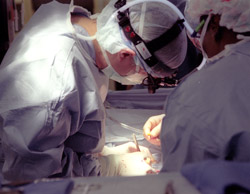A team of researchers at Washington University School of Medicine in St. Louis has found that using lobes of lungs from living donors improves the chances of short-term survival for children who require a second lung transplant.

Their findings appear in the May issue of the Journal of Thoracic and Cardiovascular Surgery.
Researchers compared the outcomes of lung retransplants in 39 children from 1991 to 2004, including 13 patients who had lung retransplants using lobes from living donors and 26 patients who received lung retransplants using whole lungs from deceased donors.
Living-donor lung retransplantation involves removing a lower lobe, or about one-third of a lung, from each of two healthy adult donors and transplanting the lobes as replacement lungs into a child.
Established in 1990, the lung transplant program at Washington University School of Medicine and St. Louis Children’s Hospital was the first freestanding pediatric lung transplant program in the United States. To date, the Washington University Medical Center has performed the most pediatric lung transplants worldwide.
All children who received lung retransplants also had their initial lung transplants at St. Louis Children’s Hospital. The majority of children needed second transplants because of bronchiolitis obliterans syndrome, a progressive decrease of pulmonary function that develops in nearly half of pediatric lung recipients within five years. The remainder had primary graft dysfunction, where the lungs don’t work effectively after transplant. Although some patients survive these conditions, in many instances, the only treatment is retransplantation.

“Living donor transplant was developed because it can be difficult to get organs quickly for patients who deteriorate rapidly, particularly patients with cystic fibrosis,” says Stuart C. Sweet, M.D., Ph.D., assistant professor of pediatrics and medical director of the pediatric lung transplant program.
This strategy also preserves the limited supply of whole lungs for children who are on the waiting list for their first lung transplant.
Until about a year ago, when patients were listed for lung transplantation, they were placed in the queue behind previously listed candidates regardless of their degree of illness, according to Benjamin D. Kozower, M.D., lead author of the study and a resident in the Division of Cardiothoracic Surgery at the School of Medicine. For children who were too sick to wait for deceased donor organs, the living-donor lobar lung retransplantation was their only option.
Allocation policy in the United States has since changed. Now, patients 12 and older are ranked based on a formula that gives priority to sicker candidates, giving them a chance at getting whole lungs from a deceased donor more quickly. Patients under 12, however, remain ranked by waiting time.
Charles B. Huddleston, M.D., professor of surgery and chief of pediatric cardiothoracic surgery at St. Louis Children’s Hospital, says using lungs from deceased donors results in long “ischemic times,” the time between removal of the donor lungs and implantation into the recipient. Surgeons have some control over timing in a living-donor lung retransplantation.

“Generally speaking, the shorter the ischemic time, the better the lung function,” says Huddleston. “That is one reason we embarked on this procedure for children requiring lung retransplantation. Our study would suggest that it is worth doing.”
The study showed that one patient of the 13 who had the lobar lung retransplant from living donors died during hospitalization, while 11 of the 26 who had the lung retransplant from deceased donors died in the hospital, primarily of graft or respiratory failure, infection or multi-system organ failure.
Based on the outcomes for the patients in the study, the investigators predicted that about 40 percent of patients who received living-donor lobar lung retransplants would survive at least five years, compared to about 29 percent of patients who had the lung retransplant from deceased donors. But that difference might not be significant enough to increase the number of living-donor lobar lung transplants, the researchers say.
“We observed what appear to be better results with the living-donor lobar lung transplants, but the risk to two healthy donors really limits our use of these procedures to patients who cannot wait for deceased donor lung donations,” Kozower says.
Kozower B., Sweet S., de la Morena M., Schuler P., Guthrie T., Patterson, G.A., Gandhi S., Huddleston C. Living donor lobar grants improve pediatric lung transplantation survival. The Journal of Thoracic and Cardiovascular Surgery, May 2006, Volume 131, No. 5.
Washington University School of Medicine’s full-time and volunteer faculty physicians also are the medical staff of Barnes-Jewish and St. Louis Children’s hospitals. The School of Medicine is one of the leading medical research, teaching and patient care institutions in the nation, currently ranked fourth in the nation by U.S. News & World Report. Through its affiliations with Barnes-Jewish and St. Louis Children’s hospitals, the School of Medicine is linked to BJC HealthCare.